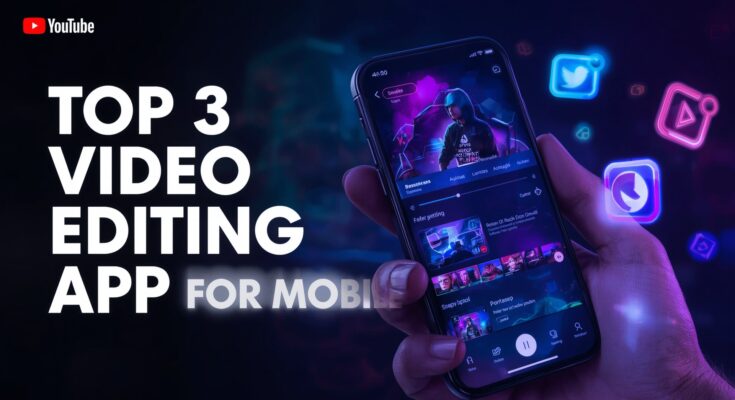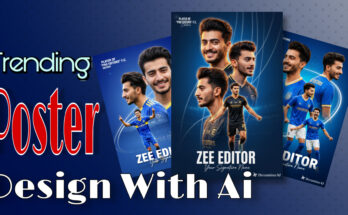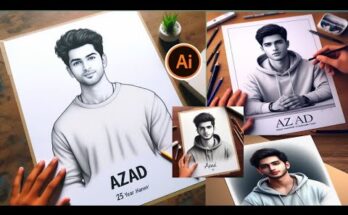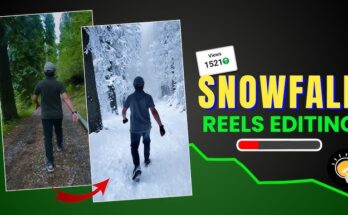Top AI Mobile Editing Apps for Content Creators in 2025 (Complete Guide — 3500+ words)
Meta description suggestion: Discover the best AI-powered mobile editing apps for photos and video in 2025 — features, pricing, workflows, pro tips, comparisons and 10+ FAQs to help content creators choose the right app and speed up production.
Introduction — Why AI on Mobile Matters for Creators in 2025
Smartphones are the camera and the studio for most content creators today. In 2025, mobile devices paired with powerful on-device and cloud AI let creators shoot, edit, and publish broadcast-quality photos and videos without a desktop. AI has moved beyond simple filters — it now performs background removal, smart object replacement, style transfer, automatic cuts, voiceover cleanup, motion tracking, and even generative scene extension — all inside mobile apps. That shift means faster turnaround, more creative experimentation, and workflows that scale for solo creators and small teams.
This guide walks through the top AI mobile editing apps you should consider in 2025, explains what each app is best at, shows sample workflows (photo and video), lists pricing/limitations, offers pro tips for social platforms, and answers common questions creators ask when switching to AI-first mobile editing.
How I chose these apps (quick criteria)
To keep this guide practical I evaluated apps by:
-
AI feature depth: generative tools (fill/extend, inpainting), enhancement (super-resolution, denoise), and automation (auto-cut, auto-color).
-
Mobile-first UX: fast, intuitive on small screens.
-
Output quality & control: how natural/controllable AI results are.
-
Exportability & integration: formats, aspect ratios, cloud sync.
-
Value for creators: free plan usefulness, pro plan ROI.
-
Market traction & recent updates (2024–2025).
Where useful, I cite recent reporting and product writeups that confirm new or notable features.
Overview: The Top AI Mobile Editing Apps in 2025 (Short list)
-
CapCut — short-form video editing with increasingly smart AI tools and templates. clixie.ai
-
Runway — generative video/photo editing with advanced inpainting, background replacement and ‘Aleph’ style model features (has a mobile-friendly interface and cloud processing). Zapier
-
Canva (Magic Studio) — mobile Magic tools for image editing, background remove, and text-to-image; excellent for creators who publish social graphics. Kripesh Adwani
-
Picsart — broad creative suite with accessible AI tools for stylization, background removal and quick social-ready templates.
-
Fotor — AI enhancers, enlarger and one-tap fixes that are fast on mobile. PERFECT
-
Lensa — portrait and style-focused generative edits for influencers and creators who prioritize headshots and stylized portraits.
-
Adobe (Photoshop Express / Lightroom Mobile / Photoshop Camera) — professional mobile editing that now bundles more AI features for masking, sky replace and noise reduction.
-
YouCam / Perfect Corp apps — AR + AI for makeup, retouching and virtual try-ons (huge footprint in beauty creators). Wikipedia
-
Wondershare Filmora / CapCut Pro-tier / VN / LumaFusion — mobile editors adding AI smart cuts, auto-color and speech-to-text editing features. Wikipedia+1
-
Google’s tools (Veo/Flow/Nano Banana integrated into Photos/Lens) — Google has rolled out new AI editing capabilities into its ecosystem in 2025, blurring the line between generation and editing on mobile. The Verge+1
Below I deep-dive into the strongest contenders, give actionable workflows, and explain which app to pick depending on your content type (short-form video, long-form video, photography, social graphics).
1) CapCut — Best for short-form creators who need speed + templates
What it is: CapCut remains one of the most popular mobile-first video editors for short-form social content. It provides templates, auto-subtitles, music libraries, and increasingly capable AI features that speed up typical creator tasks (auto cuts, automatic beat edits, background removal, and creative generative stickers/effects). CapCut’s free tier is especially valuable for new creators. clixie.ai
Standout AI features (2025):
-
Auto-subtitle generation & auto-translation.
-
One-tap smart cuts synchronized to song beats.
-
AI background removal for video and image overlays.
-
Generative effects/stickers that match visual style.
Who should use it: TikTok / Reels creators, short tutorial makers, social-first influencers who need fast edits and templates.
Typical mobile workflow (CapCut):
-
Import vertical clips shot on phone.
-
Use Auto Cut to remove silent frames and tighten pacing.
-
Run Auto Subtitle and tweak text boxes.
-
Drop a template for transitions and add an AI-generated sticker or overlay.
-
Export in the correct aspect ratio and upload.
Pros / Cons:
-
Pros: Fast, template-rich, free tier generous.
-
Cons: Less granular color control vs professional mobile editors; cloud AI may require subscription for heavy use.
(Citation: CapCut remains a top pick in best-video-app roundups for 2025.) clixie.ai
2) Runway — Best for creative generative video and advanced inpainting
What it is: Runway popularized powerful generative video editing: change skies, remove objects, extend frames, and apply model-driven transformations. While its desktop/web product is feature-rich, Runway’s mobile experience (and mobile-accessible cloud tools) bring advanced generative workflows to creators on phones. Runway’s models let you perform edits that until recently required desktop VFX stacks. Zapier
Standout AI features (2025):
-
Frame-level inpainting/object removal (works on short clips).
-
Generative “scene extension” — expand background beyond original frame.
-
Text-prompted edits for stylizing or re-lighting scenes.
-
Seamless integration with cloud rendering for heavier tasks.
Who should use it: Creators experimenting with generative visuals, storytellers who need high-impact effects, small studios and indie filmmakers on the move.
Typical mobile workflow (Runway):
-
Upload a short clip to the app.
-
Use the Remove tool to mask and inpaint unwanted objects across frames.
-
Try Extend to create extra lead-in or outtro frames for smooth transitions.
-
Apply prompt-driven stylization to get a cinematic color grade.
-
Export as high-quality MP4 for socials or desktop polish.
(Citation: Runway is widely listed among top AI video generators and editors for 2025.) Zapier
3) Canva (Magic Studio) — Best for quick social graphics and image generation
What it is: Canva’s Magic Studio features (Magic Resize, Magic Edit, Magic Grab, Magic Expand, and text-to-image) are now baked into mobile apps and are designed for creators who need polished social posts, thumbnails, and story graphics fast. In 2025, Canva’s mobile AI tools are increasingly powerful for on-the-go creation, especially for cross-platform assets. Kripesh Adwani
Standout AI features (2025):
-
Magic Resize to adapt one design for multiple platforms.
-
Magic Expand to extend backgrounds or fill extra space.
-
Magic Edit for contextual changes (e.g., change color of an object).
-
Text-to-image generator for unique visuals.
Who should use it: Social media managers, content creators who post frequently across platforms and need consistent templates.
Typical mobile workflow (Canva):
-
Start with a template for Instagram/TikTok thumbnail.
-
Use Magic Edit to swap elements or perform a background touch-up.
-
Resize with Magic Resize to produce variants for different networks.
-
Export as PNG/JPEG or MP4 (for simple animated posts).
4) Picsart — Best for creative, stylized image edits & community templates
What it is: Picsart blends social features with a powerful set of AI filters and editing tools. It focuses on mobile creativity — stylized filters, background removal, and generative art features — and maintains a large template community that creators can remix.
Standout AI features:
-
AI background removal and replace.
-
Style transfer (turn photos into painted or illustrated looks).
-
Generative image-to-image edits and text-to-image for quick concept art.
Who should use it: Creators who like highly stylized looks, meme designers, and influencers.
5) Fotor — Best for AI quick-enhance and upscaling on mobile
What it is: Fotor packages AI-powered one-tap enhancement (auto-tone, AI enlarger for upscaling low-res photos, denoise) into an accessible mobile app. The tools are optimized for quick improvement of phone photos before posting. PERFECT
Standout AI features (2025):
-
AI Enhance and AI Enlarger (super-resolution).
-
One-tap fixes for clarity, exposure and color.
Who should use it: Photographers and creators who need rapid quality improvement (e.g., turning a slightly blurred phone shot into a shareable image).
6) Lensa — Best for portrait-focused generative edits
What it is: Lensa became famous for stylized portrait generations and background swaps; in 2025 it remains a go-to for creators who want polished headshots, stylized avatars, and editorial portrait effects.
Standout AI features:
-
Portrait retouching with fine-grain control.
-
Generative avatar and stylized portrait packs.
Who should use it: Influencers, creators who run personal brands, podcasters who need thumbnails.
7) Adobe mobile suite — Best for creators needing pro controls
What it is: Adobe’s mobile apps — Photoshop Express, Lightroom Mobile, and Photoshop Camera — continue to add AI-driven features: subject selection and masking powered by Adobe Sensei, sky replacement, noise reduction, and advanced color grading tuned for mobile.
Standout AI features:
-
Professional-grade masking & local adjustments.
-
Auto-tone and adaptive presets that learn your style.
-
Integration with Creative Cloud (desktop syncing).
Who should use it: Photographers and creators who need desktop-level control on mobile and a smooth path to desktop editing.
8) YouCam & Perfect Corp apps — Best for beauty, AR makeovers
What it is: Perfect Corp’s YouCam and related apps combine AR try-ons with AI retouching. These apps are massive in reach — YouCam was reported to have hundreds of millions of downloads — and are staples for beauty influencers and makeup brands. Wikipedia
Standout AI features:
-
Real-time AR makeup & hair color try-ons.
-
Precision skin retouching and virtual product testing.
Who should use it: Beauty content creators, brand demos, livestream product try-ons.
9) Wondershare Filmora Mobile / LumaFusion / VN — Best for long-form mobile video editing with AI helpers
What it is: Mobile editors like Filmora and LumaFusion continue to push pro-level features to mobile, while adding AI helpers: auto color, speech-to-text editing, and scene detection. These apps suit creators who edit longer videos on tablets or powerful phones. Wikipedia+1
Standout AI features:
-
Speech-to-text with editable transcripts.
-
Auto-color matching between clips.
-
Smart scene detection and suggested cuts.
Who should use it: YouTubers and creators producing longer tutorials, long-form social content and documentary shorts on mobile.
10) Google’s AI efforts (Veo, Flow, Nano Banana in Lens/Photos) — Most promising integrated ecosystem
What it is: Google’s generative video and image editing experiments (Veo/Flow) — and image-editing tech like “Nano Banana” appearing in Google Lens/Photos — are bringing generative editing directly into mainstream apps. For creators, that could mean doing advanced edits in commonly used phone apps without third-party installs. The Verge+1
Why it matters: Integration into Lens/Photos means millions of users get advanced editing where they already manage photos, accelerating adoption of generative edits like scene extension and object removal.
Side-by-side comparison (short)
| App | Strength | Typical Creator | Price signal |
|---|---|---|---|
| CapCut | Short-form speed, templates | TikTok/Reels creators | Free with paid features |
| Runway | Generative video/inpainting | Visual storytellers | Freemium + credits |
| Canva | Social graphics + text-to-image | Social managers | Freemium + Pro |
| Picsart | Stylization + community templates | Meme/style creators | Freemium |
| Fotor | One-tap enhancement & upscaling | Photographers on-the-go | Freemium |
| Lensa | Portrait/generative avatars | Influencers | Paid credits |
| Adobe Mobile | Pro controls | Photographers | Subscription (CC) |
| YouCam | AR makeup/beauty | Beauty influencers | Freemium |
| Filmora/LumaFusion | Long-form mobile editing | YouTubers | Paid / one-time or subscription |
| Google (Lens/Photos) | Integrated generative tools | Mainstream users | Free (per Google rollout) |
Deep-dive workflows (step-by-step) — 3 practical examples
Workflow A — Viral 60s Reels using CapCut + Canva
-
Shoot vertical clips: multiple takes on phone (keep clips 6–15s).
-
Quick assembly in CapCut: import, use Auto Cut to remove silences. Add Auto Subtitle.
-
Apply template transitions: choose matching transition pack.
-
Polish thumbnail in Canva: export a 4:5 still from video, open Canva mobile, use Magic Edit to adjust background and add bold text.
-
Export & upload: export MP4 from CapCut and thumbnail from Canva.
Why this works: CapCut speeds the video assembly; Canva ensures thumbnail CTR.
Workflow B — Professional portrait thumbnail + branding using Lensa + Photoshop Mobile
-
Capture raw portrait with good lighting.
-
Retouch in Lensa: apply portrait retouch and stylized avatar generation.
-
Refine in Photoshop Mobile: precise masking, remove stray hairs, adjust dodge & burn.
-
Finish in Canva for layout and branding with templates.
Why this works: Lensa for instant stylistic retouch; Photoshop for pixel-level control.
Workflow C — Short explainer with generative assets (Runway + Filmora Mobile)
-
Record lecture clip on phone.
-
Upload clip to Runway: remove background, add generated scene extension and replace props with AI-generated assets.
-
Edit audio in Filmora: clean up voice, normalize levels. Add subtitles via speech-to-text.
-
Export and schedule to YouTube / socials.
Why this works: Runway handles advanced visual generation; Filmora tackles audio and longer-form edit.
Pro tips to get the best AI results on mobile
-
Start with clean source material. AI fixes are powerful, but not magic — well-lit, steady footage gives the best results.
-
Use masking when possible. Even automated tools that select subjects usually allow manual refinement — take the extra 10–30 seconds.
-
Export a master file (high bitrate). If you plan to do more edits later on desktop, export a high-quality intermediate.
-
Beware of “over-AI” looks. Generative styles can look synthetic on faces; dial back intensity for authenticity.
-
Use cloud credits thoughtfully. Some generative apps use credits for heavy edits; reserve them for shots that need the magic.
-
Protect identity & fair use. When you use generative tools to recreate likenesses or real people, ensure you have permissions.
-
Match aspect ratios early. Design for the target platform (9:16 for TikTok, 4:5 for Instagram feed) so you don’t lose important framing later.
-
Keep presets and templates. Build a mobile “kit” of templates, LUTs, and watermark presets to speed up publishing.
Pricing & limits: what to expect in 2025
In 2025 most apps use a freemium model with some combination of:
-
Free tier with basic AI features and watermarked exports or limited resolution.
-
Subscription / Pro unlocking cloud rendering, longer export lengths, higher resolutions and commercial licenses.
-
Pay-per-credit for heavy generative tasks (Runway, Lensa-style avatar packs).
Examples: CapCut remains very usable for free creators (templates and basic AI tools available in free tier), while Runway and some Canva Magic features use credits or pro subscriptions for heavier generation. Fotor and Picsart provide useful free AI enhancers but restrict batch processing and high-res exports behind a paywall. clixie.ai+1
Ethics, copyright & safety (short primer)
-
Generated content & likenesses: Don’t use AI to fake people in ways that could mislead (deepfakes), especially in political contexts or to harm reputation.
-
Copyrighted material: Many AI generators are trained on large datasets; avoid generating content that explicitly reproduces copyrighted characters or trademarked logos for commercial use unless licenses are clear.
-
Platform rules: Some social platforms have rules about synthetic media (labeling may be required).
-
Model biases: AI edits can introduce biases (e.g., skin tone shifts). Always check and correct.
Frequently Asked Questions (10+ detailed answers)
1. Which single app should I start with as a solo creator?
If you make short-form video, start with CapCut for speed and templates. If you primarily create images or thumbnails, try Canva for Magic Studio. For portrait-first creators, test Lensa for quick stylized portraits. These apps have the lowest barrier to entry and generous free tiers. clixie.ai+1
2. Are mobile AI edits better than desktop anymore?
Mobile AI tools can match desktop for many tasks (background removal, quick color grading, denoise) thanks to cloud processing and on-device ML. For heavy compositing, fine VFX or color grading on long timelines, desktop still offers more precision — but mobile is closing the gap fast.
3. Do these AI edits count as “original” content for monetization?
Platforms have different rules. Some require disclosure of synthetic content; others accept AI-created assets if you hold rights to the outputs. Check the platform monetization policies and the app’s terms to confirm commercial use rights.
4. Which app is best for upscaling old phone photos?
Fotor and certain dedicated AI upscalers (some integrated into Picsart and Photoshop Express) provide excellent super-resolution with minimal artifacts. Always compare results and avoid extreme upscaling without human touch. PERFECT
5. How heavy are cloud AI features on data usage and battery?
Cloud generative edits upload and download media and can be data-heavy. Use Wi-Fi for big projects and expect higher battery and processing use when apps do on-device inference.
6. Can I edit 4K mobile footage with these apps?
Yes — many apps support 4K export on paid plans. However, cloud rendering or device capability determines speed and feasibility. LumaFusion and Filmora offer strong 4K support for tablets and higher-end phones. Wikipedia
7. How does privacy work when uploading content to cloud-based AI editors?
Read the app’s privacy policy: some apps claim they don’t retain uploaded media; others store content for model training or caching. For sensitive client work, prefer on-device editing or paid enterprise options with contractual terms.
8. Are the generative styles consistent across apps?
No — each app uses different models and training sets. For consistent branding, choose one app for stylized outputs or create custom LUTs/filters that you reapply.
9. What’s the fastest way to make subtitles for mobile video?
Use apps with built-in auto-subtitle generation (CapCut, Filmora, Adobe Premiere Rush mobile). They transcribe audio and let you edit text boxes; some also offer auto-translation. clixie.ai+1
10. Will AI replace human editors?
AI augments editors, automating repetitive tasks (syncing, rough cuts, color matching). Human editors still add creative judgment, narrative pacing, and brand nuance. AI speeds up workflows, but it doesn’t remove the need for creative direction.
11. Which apps are best for beauty and AR content?
Perfect Corp’s YouCam suite leads in AR makeup and virtual try-ons — widely used by beauty creators and brands for demos. Wikipedia
12. How do I avoid an “over-edited” look when using generative beauty tools?
Apply effects subtly, use layer opacity to blend, and compare the edit to the original. If skin texture or eyes look unnaturally smooth, dial back the retouch and keep imperfections that give realism.
13. What’s changing in 2025 that creators should watch?
Integrated generative tools in mainstream apps (Google Lens/Photos “Nano Banana”, native social-app AI) are making advanced edits accessible without separate tools. Expect more in-app generative features and better on-device ML to reduce reliance on cloud credits. The Times of India+1
Putting it all together — recommended stacks by creator type
-
Short-form social creator (speed): CapCut + Canva + Picsart.
-
Photo-first influencer: Lensa + Adobe Mobile + Canva.
-
YouTuber / long-form editor: Filmora or LumaFusion + Runway (for VFX) + Adobe Cloud.
-
Beauty / AR influencer: YouCam + Photoshop Mobile + Canva for layouts.
Common mistakes and how to avoid them
-
Relying only on AI suggestions. Always review and refine.
-
Ignoring export settings. Check bitrate, color space and resolution for platform.
-
Using heavy generative edits for brand assets without testing. Always A/B test thumbnails and ads.
-
Forgetting accessibility. Add readable subtitles and color-contrast-checked thumbnails.
Final verdict — what to pick in 2025?
There’s no one-size-fits-all app. The best strategy is to mix tools: pick a fast mobile-first editor for day-to-day content (CapCut or Picsart), a generative specialist for complex edits (Runway), and a design/publishing tool for thumbnails and graphics (Canva). For photography-first creators, pair Lensa or Fotor with Adobe Mobile for fine control.
The mobile AI landscape in 2025 makes it realistic to run an entire content business from your phone — promising faster iteration, lower production costs, and new creative possibilities. But remember the human in the loop: AI is a creative assistant, not a replacement for creative decision-making.
Appendix — Short guide to choosing the right plan (budget quick checklist)
-
$0–$10/month: Great for hobby creators — CapCut free, Canva free, Picsart basic.
-
$10–$30/month: Unlocks pro templates, higher-res exports and some cloud generative credits — Canva Pro, Picsart Premium.
-
$30+/month or credits model: For heavy generative use, cloud rendering and collaboration — Runway credits, Adobe CC, advanced Filmora plans.
5 quick actionable experiments to run this week
-
Create 3 vertical shorts in CapCut using different templates — track engagement.
-
Take one portrait and run it through Lensa, then refine in Photoshop Mobile — compare CTR on thumbnails.
-
Use Runway to remove an object from a 10s clip — test for artifacts across multiple frames.
-
Upscale an old photo in Fotor and compare pixel-level detail vs original.
-
Use Canva’s Magic Expand to make cover art that fits both YouTube (16:9) and Instagram (4:5) — measure time-saved.
Closing — Your next step
Pick one workflow above, try it on a real project this week, and keep the AI as your helper — not the final decision-maker. If you want, I can tailor a step-by-step mobile-only workflow for your exact niche (e.g., beauty reels, tech tutorials, travel vlogs) listing settings, templates and export specs to maximize reach. Tell me your niche and I’ll give a ready-to-use mobile workflow and caption templates.



